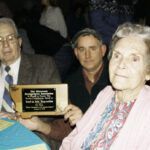By Jean Schurman

The Bitterroot Stockgrowers held their annual banquet Saturday night in Stevensville. One of the most anticipated events of the evening was the naming of the Stockgrower of the Year. This year, the group honored one of the founders of the organization, Earl Reynolds, and his wife, Ida.
The couple left Stockton, Utah, in 1963, with their four children, Janell, Layna, Butch, and Cristi, and moved to a ranch on the south side of Hamilton Heights Road, southeast of Corvallis. Reynolds had shipped his cattle and equipment via the railroad and after a slight delay (the shipment went to Corvallis, Oregon), the crew settled in and began ranching.
Reynolds raised Hereford cattle to begin with and was a forward thinker with regard to cattle ranching and producing grass for the cattle. In 1964, he put in the first gravity flow sprinkler system from the Big Ditch. He had to obtain permission from Countess Bessenyey as the pipeline ran through the Stock Farm. In the mid 1960’s, a group of ranchers went together to purchase the Petersen ranch on Chaffin Butte, northeast of Corvallis. Reynolds, Del Carter, Arnold Raudsep, Don Dobberstein, Eugene Tingle, Eldon Bingham, Harold Bryson and Bill Ferguson formed the Hunter Grazing Association and used the property for fall and winter grazing for their cattle.
It was also in that decade that Reynolds and a few other stockmen organized the Bitterroot Stockmen’s Association, the precursor to the current stockgrower’s association. The stockmen decided to bypass the middleman and take their cattle directly to the feedlot in Omaha, Nebraska. Using the railroad, about 20 local ranchers shipped 30 to 35 carloads of calves to Omaha. One or more ranchers actually rode with the cattle to the stockyards. They stopped once, usually in Laurel, Montana, to let the cattle off and feed and water them before finishing their trip. Once there, the cattle were rested for a few days and then sold through the auction. The group had developed what would become an industry standard of pre-conditioning the cattle prior to shipping. This included when they were weaned, a series of inoculations to limit shipping fever and other problems the cattle might develop. This program was so successful that the John Deere Company made a short film about it. Reynolds was one of the interviewees in the program. (A side note, the film was made here in the valley and featured not only Reynolds but also many other ranchers in the valley.)
Reynolds, Quentin Brown and Morris Gardner purchased the Hamilton Sale Yard in 1968 and ran it for a while. Reynolds also served on the Farm Bureau, and on many other boards. He was always helping someone, whether it was a rancher with haying or 4H members with their animals.
Reynolds switched from Herefords to Red Angus in the 80’s and continues to raise them. They had several production sales at the ranch. A few years ago, the Earl and Ida moved to Ekalaka, Montana, where they work with their son, Butch. Reynolds proudly pointed out that of the 6,000 plus cattle that were sold through the Miles City auction barn this year, their cattle garnered the highest prices.
Throughout the years, Ida Reynolds was the support behind the scenes. Whenever there was a branding, a trail drive or a sale, she was there to provide a good meal for the crew. Ida worked for Marcus Daly Memorial Hospital for 30 years while she was wrangling the kids and keeping everything going at home. No matter what their children did, Ida was there on the sidelines cheering them on. In fact, the entire Reynolds family had one eye on their cell phones at the banquet Saturday night as their grandson, Josh, was competing at the Montana PRCA Circuit Finals in Great Falls.